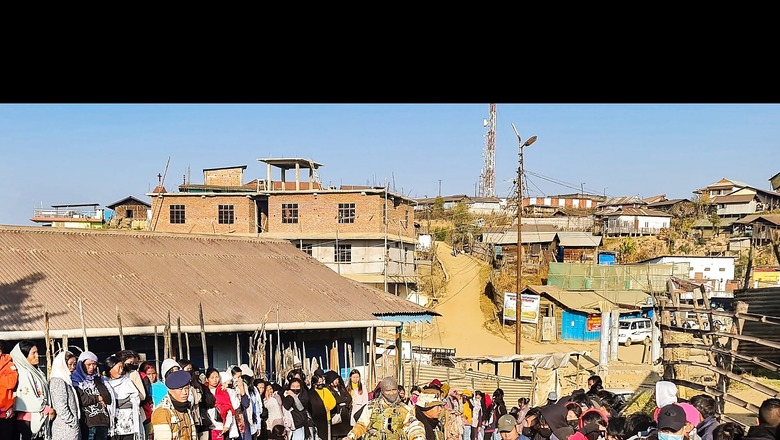
views
Agartala, Kohima and Shillong are so far away from the heat and dust of Delhi that elections in the North East have too often in the past been seen by many in the rest of India just as passing footnotes. As Meghalaya and Nagaland vote, make no mistake, the current polls have significant national implications. Tripura has already voted and the results in these three states will provide telling pointers on the sustainability of deeper shifts in India’s polity.
First, over the past eight years, the BJP gradually replaced the Congress as the primary national party in the northeast region. The results on March 2 will be a marker of the long-term durability of that deeper shift.
Five years ago, in Nagaland, the Naga People’s Front (NPF) was the largest party with 26 of 60 seats, but CM Neiphiu Riu’s Nationalist Democratic Progressive Party (NDPP), with 17 seats, and the BJP, with 12 seats, formed a coalition government. This time, they are continuing their alliance — NDPP fighting on 40 and BJP on 20 seats.
The BJP has already opened its account with one of its candidates, Kazheto Kinimi in Akulotu constituency, being elected unopposed. With Congress contesting in 23 seats in Nagaland, the state poll will be a key test case.
Similarly, in Meghalaya, since the last elections in 2018, politics has changed considerably. The Congress, which had 21 MLAs in the 60-member House last time, has lost all of them since then in defections to the Trinamool Congress and others.
The BJP, which had two seats in 2018, had earlier joined hands with Conrad Sangma’s National People’s Party (NPP) and the ruling alliance, but has since parted ways. Union Home Minister Amit Shah has attacked Sangma on the campaign trail for doing “family politics”. The party is fighting on all 60 Assembly segments this time.
The Congress is fighting on all 60 constituencies as well. Queering its pitch is the Trinamool Congress, led by former chief minister Mukul Sangma who defected from Congress with a handful of MLAs and has thrown down the gauntlet. In a state where the Congress claims it has been rebuilding its leadership, and various sides are using the ‘outsider’ narrative, the political chessboard has, in that sense, been significantly rearranged.
At a time when the Congress is positioning itself as the lynchpin of Opposition unity ahead of 2024, Meghalaya offers a microcosm of the nature of the challenge there, with regional parties like Trinamool Congress.
Second, Meghalaya and Nagaland are both largely tribal states with mostly Christian populations. These are both groups that the BJP has assiduously wooed in recent years.
As much as 87.9% of Nagaland and 74.4 % of Meghalaya is Christian. BJP’s electoral advances in these and other northeast states after 2018 allowed the party to claim that it was more than a Hindi–Hindu party. It’s strategic adaptability in the region, operating very differently from its messaging in the Hindi heartland, made the symbolism of victories in these states huge. The party’s outreach in the Northeast operates differently, compared to the Hindi heartland.
In Tripura, the BJP, which overturned the Left in 2018, faces a renewed challenge this time from Tipraha Indigenous Progressive Regional Alliance (TIPRA Motha). The outcome will be a good test of the impact and durability of the massive shift its rise engendered in the state’s traditional politics, which was divided between the Left and the Congress.
Third is the narrative of development and the idea that focused spending on the region has increased significantly since 2014. This is the primary push in the BJP’s political outreach, where it been seeking to constantly distinguish between its approach and that of Congress governments.
PM Narendra Modi in his last rallies in Meghalaya and Nagaland, for example, accused Congress governments of “using the Northeast like an ATM”. Now, he said, the region was seen as a “growth engine” for India, emerging as he put it, as “Ashtlakshmi” (eight forms of the Goddess Lakshmi).
This political framing by PM Modi is based on significantly increased government spending on the region in recent years. Approved central spending on schemes for the region amounts to Rs 12882.2 crore, for the balance period of the 15th Finance Commission (2022-23 to 2025-26). Most recently, PM-DevINE (Prime Minister’s Development Initiative for North East Region) for progress in the region earmarked Rs 6,600 crore between 2022-23 and 2056-26.
The BJP won 14 of 25 Lok Sabha seats in the Northeast in 2019, emerging as the single largest party in the wider region. As we head into the next national election in 2024, its changing fortunes here will not only have a significant impact overall but also hold immense symbolic value. This is why the results in these three states will be crucial weathervanes and an important pointer to the road ahead.
Nalin Mehta, an author and academic, is the Dean of School of Modern Media at UPES University in Dehradun, a Non-Resident Senior Fellow, Institute of South Asian Studies at the National University Singapore, and Group Consulting Editor, Network 18. He is the author of The New BJP: Modi and the Making of the World’s Largest Political Party. Views expressed are personal.
Read all the Latest Opinions here




















Comments
0 comment